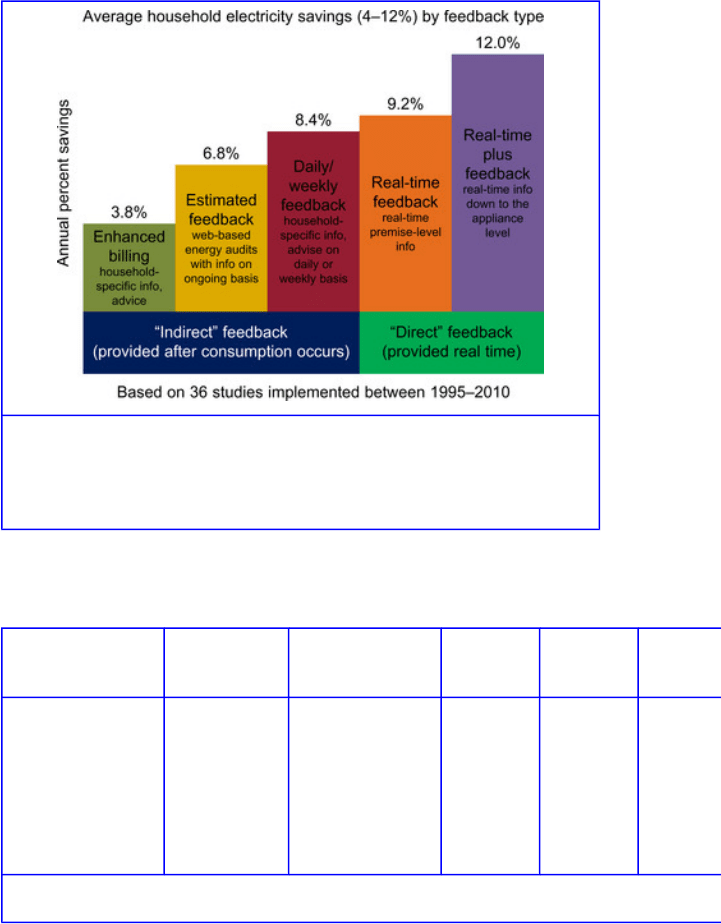Sioshansi F.P. Smart Grid: Integrating Renewable, Distributed & Efficient Energy
Подождите немного. Документ загружается.

can learn from these experiences. Key lessons that can be
drawn from these cases include:
• Share risks and costs. The MD PSC made it clear that
the initial BGE submission put too much of the cost and
risk burden on customers, and the IL court decision seems
to reinforce that point.
• Demonstrate benefits before seeking cost recovery.
The MD PSC ultimately accepted BGE's revised proposal
when it sought to recover costs after deployment. Even
though BGE had run an AMI pilot and showed some
benefits from that, the PSC did not see a strong enough
case for systemwide ratepayer cost recovery prior to
deployment.
• Don't mandate time-based pricing for smaller
customer classes. This may not be an issue in every
jurisdiction, but in many states consumer advocates have
made strong cases against class-wide pricing plans that
involve critical-peak pricing, time-of-use pricing, or other
rate structures that tie prices to time of use. This implies
that such pricing plans will have to be marketed actively to
gain the high market penetration rates needed to fully
realize the benefits of smart grid technology, but if this is
the path to initial regulatory approval, then that may be the
reality smart grid deployment faces in many states. This
approach may actually be helpful in the long run, as it
could force utilities to learn more about customers, market
segments, customer preferences, and the specific bundles
of technologies and services that will catch on in various
segments.
701
Utility and Customer Implementation Experience
with Smart Grid and Related Deployment
Programs
Deployment of smart grid technology, especially in the form
of advanced metering, is beginning to be seen on a wide
scale, as the FERC report cited above indicates. We have
reviewed a selection of the ample literature of utility and
customer experience with smart grid and related customer
offerings from which we seek to distill a few key lessons
learned, and to glean insights for the future of
smart-grid-based offerings.
Pilot programs and other initial field experience with
smart-grid-related customer offerings tend to show that
customers reduce energy use as well as peak demand. Most of
this experience comes from dynamic-pricing-based offerings,
though some also include customer feedback and control
options. For example:
• King and Delurey's [9] meta-review found that dynamic
pricing produced average savings of 4% of annual energy
use. However, reliability-oriented demand response
programs reduced energy consumption by only 0.2%,
largely because event-driven programs are activated well
under 100 hours per year. Information/feedback programs
showed stronger savings effects, up to 11%; these typically
give customers usage information via the internet or
in-home displays but do not involve direct load control.
They also found that savings varied greatly, from −5% to
20%, which serves to warn against placing predictive value
on these results.
702
• ACEEE's [10] meta-review of 36 customer feedback
programs in North America, Europe, and Asia found that
energy savings can range from 3.8% to 12%. Figure 14.4
illustrates the results for the five categories of programs
analyzed. The first two categories, enhanced billing and
estimated feedback, do not require advanced metering, and
so are not dependent on smart grid technology. The three
highest categories of savings, however, come from
programs that require AMI as a minimum; the highest
savings category involves real-time feedback down to the
device level. As with King and Delurey, however, the
sample size is not large enough to be used for predictive
purposes.
• The National Action Plan for Energy Efficiency [1] report
on utility rate design included a review of the energy
savings impacts of several recent dynamic pricing
programs. Those results are summarized in Table 14.1; it
shows annual energy savings as high as 7.6%, occurring in
the Ontario Hydro One pilot, which combined AMI with
in-home displays (IHDs) in half the participating homes.
Savings in homes without the IHDs averaged 3.3%, less
than half the IHD group. The literature search for this
report also reflected a consistent theme in
smart-grid-related field programs—relatively few of them
measure annual energy savings data. This is understandable
to the extent that the purpose of the program was peak
demand reduction, not annual energy savings. But given
the challenges facing smart grid deployment in terms of
documenting customer benefits, it is vital that more data be
collected on the annual energy savings impacts of
smart-grid-based customer offerings.
703

Figure 14.4
Energy savings from customer feedback programs.
Source: ACEEE [10]
Table 14.1
Energy and Demand Savings from Dynamic Pricing P
Program
Rate/Price
Type
Location
Customer
Type/Load
Size
Participants
Custom
Incenti
California Statewide
Pricing Pilot
CPP
Southern California
Edison Service Area
Commercial/
industrial
<20 kW
59 in 2004:
57 in 2005;
about 33%
accepted
thermostats
Free install
of smart
thermostat t
automatical
adjusts air
conditionin
setting in C
periods
Sources: California Statewide Pilot: George et al. (2006); Gulf Power Company: comments from Er
Energy Board: Hydro One (2006); Community Energy Cooperative: Summit Blue Consulting (2004
704

Commercial/
industrial
20–200 kW
83 in 2004:
76 in 2005;
about 60%
accepted
thermostats
Gulf Power
Company—Energy
Select
Price-responsive
load
management
with CPP
Gulf Power
Company service
territory—northwest
Florida
Residential 8,500
None—cust
pay $4.95/m
to participat
the program
the opportu
save on the
electric bill
purchasing
electricity a
prices lowe
the standard
87% of the
Ontario Energy
Board/Hydro One
Regulated price
plan TOU rates
Hydro One service
area
Residential,
farm, small
business
under 50 kW
500
Real-time
in-home dis
monitors fo
the particip
Ontario Energy
Board—Smart Price
Pilot
Regulated price
plan TOU; TOU
with CPP; TOU
critical-peak
rebate
Hydro Ottawa's
service territory
Residential
TOU
scheduled to
have smart
meters
installed
prior to the
start of the
pilot
373
participants
total: 125 in
a
critical-peak
rebate price
group, 124
each in
TOU-only
and CPP
groups
CPP partici
off-peak rat
to 3.1 cents
kWh to offs
critical-peak
price TOU
rebate
participants
refund of 3
cents per kW
below base
usage +$75
end of pilot
Sources: California Statewide Pilot: George et al. (2006); Gulf Power Company: comments from Er
Energy Board: Hydro One (2006); Community Energy Cooperative: Summit Blue Consulting (2004
705

Community Energy
Cooperative—Energy
Smart Pricing Plan
Hourly pricing
pilot program;
air-conditioning
cycling added as
an option
Chicago Residential
750 in 2003,
rising to 1,
100 in 2006
Cooperativ
provided
outreach,
education,
information
materials, h
price alerts
Sources: California Statewide Pilot: George et al. (2006); Gulf Power Company: comments from Er
Energy Board: Hydro One (2006); Community Energy Cooperative: Summit Blue Consulting (2004
These studies make it clear that smart-grid-based programs
can save energy as well as reduce peak demand, suggesting
that there is no inherent conflict between energy savings and
peak reduction goals. What is more relevant to the current
debate on smart grid technologies, in our view, is examining
the factors that support success in gaining customer
acceptance and regulatory approval. Toward that end, we
have selected for a more detailed look three smart grid
deployment projects, chosen for the key lessons they offer on
the positive benefits that smart grid technologies and
customer offerings can offer. They are the Grounded Power/
Cape Light Compact pilot program in Massachusetts, the DC
PowerCents pilot in Washington, DC, and PG&E's
Monitoring-Based Commissioning (MBCx) program in
California.
Massachusetts. Grounded Power, a startup smart grid
company, designed and managed this pilot project for the
Cape Light Compact, group of publicly owned distribution
utilities in southeastern Massachusetts. The Residential Smart
Energy Monitoring Pilot program was launched in 2009 to
706
evaluate potential energy savings from in-home display
online energy monitoring systems, and to gain insight on
behavioral aspects of energy use [12]. It recruited 100
households in the Cape Cod and Martha's Vineyard areas.
Participants had in-home monitoring systems installed for a
year, received information and training on them, and had
access to an internet-based dashboard, which provided
feedback via real-time viewing of current energy use and
demand; showed customer savings in kWh, dollars, and CO2
emissions; and contained learning opportunities for
energy-saving behaviors (e.g., unplugging chargers when not
in use).
Perhaps most interestingly, the Cape Light pilot did not rely
on AMI technology. It installed monitoring devices on the
main electrical panel in participants' homes, and then
connected the IHD devices to the monitors. The pilot focused
primarily on customer feedback and behavior, which are the
core of the demonstration of smart grid benefits, without
specifically using smart grid technology. This suggests that
smart grid pilots should include such tests of customer
feedback and behavior early in the smart grid process, to
document the benefits and perhaps help build the case for
smart grid technology deployment with its costs.
The Cape Light program also engaged customers up front,
inviting them to set energy savings goals of their own
choosing, and then supporting their chosen goal with specific
suggestions for the best mix of hardware measures and
behaviors to accomplish the goal. The online features of the
program also included the ability to compare participants'
experience with others, and even allowed participants to
communicate, compare notes, etc. An apparent effect of this
707
approach was to give customers a sense of ownership of the
program. Rather than the utility forcing AMI, time-based
pricing, and perhaps other services in a one-way fashion, this
program was perceived more as customer-driven. This feature
was also true of the Boulder Xcel program, but was largely
lost in the controversy over the costs of infrastructure
development.
By focusing only on customer feedback and behavior, and by
giving customers wide control over how they used the
program, Cape Light may have paved the way for greater
customer acceptance over time, and may ease the way for
customers' willingness to absorb future costs of AMI
infrastructure. It is also important to point out, however, that
Cape Light is a publicly owned utility, and thus has less
regulatory oversight than an IOU. Yet the costs of the pilot
appear to have been modest, so many IOUs could likely have
justified such costs, although no cost data or
cost-effectiveness analysis was provided in the evaluation.
This lack of cost/cost-effectiveness data may prove to be a
shortcoming if this project is used to justify a broader smart
grid deployment program.
The Cape Light program was a success by the measures used
in the evaluation: participants saved an average of 9.3% of
annual electricity costs, corrected for weather and other
factors. Recruiting efforts found over 300 willing participants
through very limited local media advertising; only 100 were
needed. Customers were very satisfied overall, with over 90%
interested in continuing participation, and with a reported
willingness to pay an average $8/month for future
participation. While customer bill savings were not provided,
data indicate that monthly savings significantly exceeded $8.
708
Washington, DC. The PowerCents DC
™
program was not
overly distinctive in its core content: it tested three dynamic
pricing plans in a sample of 900 customers for a year between
2008 and 2009 [13]. These pricing approaches—critical-peak
pricing (CPP), peak-time rebate (CPR) and hourly pricing
(HP)—have been tested elsewhere. What is most interesting
about the DC pilot is its organizational structure:
PowerCentsDC
™
is structured as a nonprofit organization,
with major stakeholders actively engaged, including the
incumbent utility Pepco, the Public Service Commission, the
Office of Peoples Counsel, the Consumer Utility Board, and
the International Brotherhood of Electrical Workers. The pilot
also focused intensely on limited-income customers, as this
population is often described as not likely to gain the benefits
of smart grid technologies.
This combination of utility, regulator, consumer advocate,
and labor interests is a notable departure from the more
typical proceedings involved in smart grid deployments in
regulated IOU service areas. As noted in the Maryland case
above, the dynamics of smart grid deployment cases can be
much more negative. In this situation, the major stakeholders
were not only engaged, but in some cases actively
championed the program. One PSC commissioner has
presented the program to national audiences such as NARUC
(National Association of Regulatory Utility Commissioners)
and the U.S. Department of Energy.
PowerCentsDC
™
produced positive results in terms of peak
load reduction—as high as a 33% average reduction.
Customers supplied with smart thermostats reduced peak load
even more, as much as 49%, largely because they were able
to curb air conditioning usage during peak periods. Customers
709
showed a high degree of satisfaction with the program, even
though monetary bill impacts were typically small, as the
program was designed to be revenue-neutral. Limited-income
customers signed up at higher rates of participation than
customers overall, and showed comparable levels of load
reduction.
This pilot suggests two key lessons. First, engage key
stakeholders and make them part of the deployment planning
and implementation process. While PowerCents was a pilot,
and no final PSC decision has been reached, it is likely that
key parties will be less negative in upcoming proceedings.
Second, provide customer-enabling technologies: the smart
thermostats not only increased average peak savings but also
served to address a common consumer advocate complaint,
which is that AMI deployments often come without giving
consumers a way to respond. What is not stated in the pilot
report, but which may be another key lesson, is that no
customer cost recovery was proposed prior to or during the
pilot. This supports the notion expressed elsewhere in this
chapter that it is preferable to demonstrate customer benefits
before asking for cost recovery.
California. This case study focuses not on the residential
customer class, but on large commercial customers, as
targeted by PG&E's cutting-edge Monitoring-Based
Commissioning (MBCx) program. MBCx takes advantage of
advanced metering, combined with modern commercial
building automation systems, to conduct advanced diagnosis
and performance improvement of building energy system
operations. PG&E has contracted with third-party
energy-efficiency firms to implement the MBCx.
710
